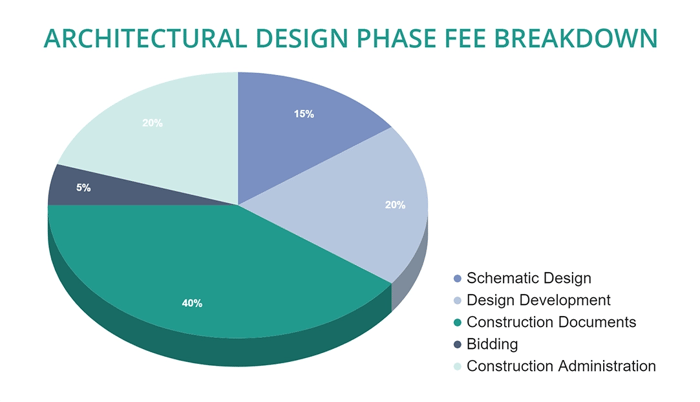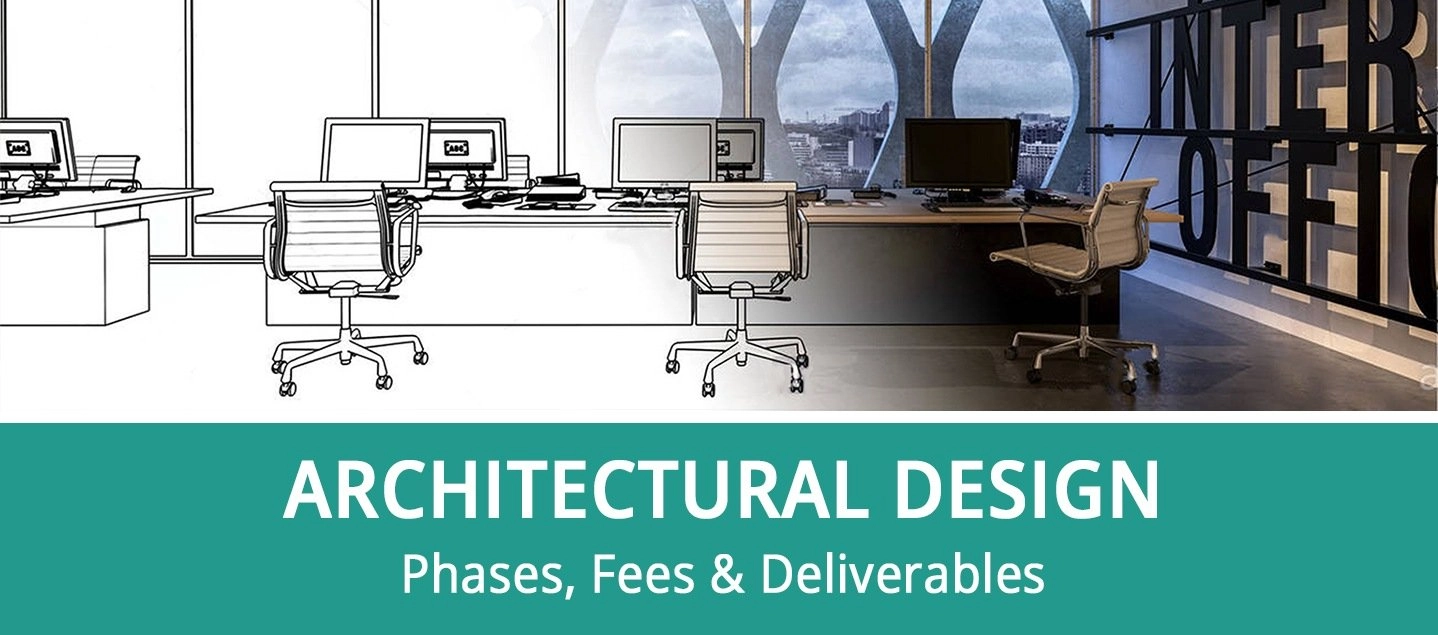If you have an upcoming construction project, it’s important to familiarize yourself with the architectural design phases. Learning the lingo and purpose behind each phase will give you a better understanding of what an architect does, what deliverables to expect, and how the client fits into each step.
Why are design phases important?
Creating a commercial space can be a long and complex process.
For consistency and clarity across all projects, the phases have been defined by the AIA. By breaking projects into phases, everyone can operate in lockstep and know what to expect and when to expect it. This structure helps to align expectations across stakeholders.
Following the phases also makes it easier for architects to plan and manage a project. This way, they can be more effective and deliver better results.

What are the architectural design phases?
The American Institute of Architects (AIA) outlines the five phases of design as:
Click on any of the steps above to jump to that section.
However, an additional phase, called programming or pre-design, is often available as an add-on service. While not technically part of the design phases, it can help ensure the project runs as smoothly as possible. With that in mind, we’ll begin by going over “step zero.”

0. Programming
Goal: Uncover important information, identify potential roadblocks, and define what a successful end result looks like.
Deliverable: Program of Requirements, the exact format will vary by firm but likely a catalog, tabulation, or summary of all the pertinent information that was collected.
According to the AIA, programming –or pre-design– isn’t a phase of design, rather a responsibility of the owner. Not all clients need an architect for this step, but many choose to bring one on since it’s the launching point for the rest of the project.
The aim is to gather all the information needed to begin the project. The client answers questions about their wants, needs, and problems. Then they'll discuss how much space they need now and in the future and how to utilize that space. They may also conduct additional research, analysis, and surveys. No drawings or designs are created during programming. Instead, you focus on defining the design scope of work and begin discussions around budget and schedule.

1. Schematic Design
Goal: Create a basic design for the shape and size of the space.
Deliverables: Preliminary drawings, like floor plans. Sketches or renderings may also be available.
The first actual design phase, schematic design, is conceptual with lots of rough sketches. Designers take all the information collected during programming and create a set of preliminary drawings.
There will be a lot of collaboration and back-and-forth with the client, but it's one of the most fun phases of design! You get to begin creating a space that your clients will love.
Schematic design is about creating an outline for how the building will look and function without getting bogged down by the details.
Clients will need to provide written approval of the schematic design before progressing to the next phase. This is crucial since changes are the easiest (and cheapest!) to make now.

2. Design Development
Goal: Refine and develop the design with more details and specifications.
Deliverables: A more detailed set of drawings, specification book, and updated cost estimate
The designer will revise the schematic design, refining the concepts and capturing more detail. Preliminary engineering starts, materials are selected, product selection begins, etc. For the first time during the project, everyone can start to get a feel for the actual space.
Design development can be a fun or stressful phase for some clients, but it's an architect's job to guide them through the design process. A good designer will provide clients with all the information they need to make important decisions confidently.
The client will receive more detailed drawings and, most likely, a specification book. The specification book goes into what will be done and how it will be done. It’s like an instruction manual for the drawings.
If it's a design-build project, this is a good time to include the build team. They can provide critical insight on implementation and provide preliminary cost estimates. Getting a cost estimate now will ensure the project scope is in line with the client's budget. If adjustments need to be made, it's more efficient (and cost-effective) to address them now.

3. Construction Documents
Goal: Create even more detailed and comprehensive drawings and get documents submitted to local authorities.
Deliverables: Complete set of construction drawings and specifications.
In the third phase, the design is finalized, a complete set of drawings are produced, and all construction documentation is prepared. This includes drawings, details, dimensions, notes, and technical specifications necessary for bidding, permitting, and construction.
Permit drawings are sent to whatever local authority has jurisdiction. They need to be submitted in a timely manner since you’ll have to wait for approval. Then the next set of drawings are created.
Construction drawings have information vital for the contractor, fill in all the details, and include every design element. They contain information like:
- Floor Plans
- Schedules (Door, Window, etc.) and Wall Types
- Electrical Drawings
- Mechanical Drawings
- Technology Drawings
- Specialty Consultant Drawings
Having high-quality and complete construction documents is essential to getting accurate bids. Accurate bids are vital to keeping your project on schedule and within budget.

4. Bidding
Goal: Select a construction company to build the project
Deliverables: The architect won’t provide any physical deliverables per se, but they can help the client review submittals and select a contractor
During the bid phase, you will select the best construction company for the project based on cost and qualifications. If you’re working with a design-build partner, this phase is eliminated from the process.
It’s important to note that the builder will sign a contract with the client, not the architect. But the architect is still involved, assisting the client with the bidding process. They will review bid submittals and help select the best fit for the project.
There are two bid methods:
Negotiated Bids
The architect may recommend a particular contractor, or the client may already have one they want to use. In this instance, the architect works with the contractor to answer questions and provide any additional documentation. The contractor needs to develop a cost and proposal for the build.
Competitive Bid
The competitive bidding process is more complex. A list of potential contractors needs to be compiled and sent bid packages. Then submitted bids will need to be reviewed, analyzed, and compared. It's essential to make sure that the construction proposals align with the drawings; an accurate bid will be apples to apples.

5. Construction Administration
Goal: Present the client with their dream space, on time and within budget.
Deliverables: Progress photos, field reports, unexpected change orders, and a punch list.
The final phase is watching the design come to life. Most of the architect's work is completed at this point, but they need to make sure their vision comes to life according to the CDs and specifications. So the architect will monitor and observe the construction, answer questions, provide updates, and help solve problems as they inevitably arise.
As problems come up, the architect will have to work with the contractor to address questions, issue change orders, and solve problems. Communication between these two teams is essential to keeping the project on schedule.
Once construction is complete, an architect will do a final walk-through and develop a punch list. A punch list notes any remaining items that still need to be completed. After these items are addressed, the project is officially complete.
Architectural Fees
Architectural design fees will vary by firm and project but serve as a guideline of how an architects’ resources are distributed through a project. Knowing what percentage each design phase should be of the total cost will help you stay on budget.
The programming phase isn’t included since it’s typically an add-on service or handled by the client.
Here is the architectural design fee breakdown by percentage:
- Schematic Design: 15% of Architectural Fees
- Design Development: 20% of Architectural Fees
- Construction Documents: 40% of Architectural Fees
- Bidding: 5% of Architectural Fees
- Construction Administration: 20% of Architectural Fees

Of course, these percentages can vary depending on client requests, size of the project, number of revisions needed, specific deliverables, etc.
Undergoing a large construction project is a big financial commitment, but knowledge is power. Knowing the architectural design phases –Programming, Schematic Design, Design Development, Construction Documents, Bidding, and Construction Administration– means you'll have a plan to follow. After reading this article, you should also know the goals and deliverables expected from each of these phases.
If you need a reminder as you take on your next project, download our Architectural Design Phases Cheat Sheet to serve as a refresher.



Leave a Comment